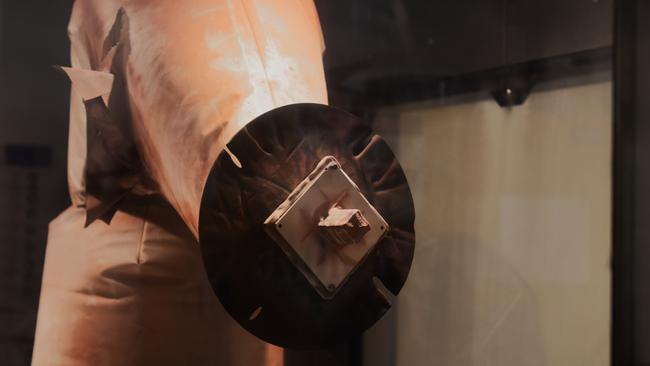Darwin company SPEE3D contributes to Ukraine war effort
While the Albanese government is sending arms and munitions to the Ukrainian front, a 3D metal printer developed in Darwin has won the approval of President Zelenskyy’s troops.

Northern Territory
Don't miss out on the headlines from Northern Territory. Followed categories will be added to My News.
As the Australian government provides artillery, protected mobility vehicles and ammunition to Ukrainian soldiers, a Territory-born, 3D metal printing innovation is making a subtle contribution to the frontline, delivering crucial vehicle replacement parts and tools into the hands of President’s Zelenskyy’s men.
Invented in the Territory by Charles Darwin University alumni Steve Camilleri and Byron Kennedy, SPEE3D uses cold spray technology to print products such as wrenches, vehicle exhausts, and propellers in just minutes.
The invention fast-tracks the supply process that would usually drag out for hours, or days.
The printer model, which resembles a small shipping container, can be transported and planted with ease, ensuring the design’s survivability in hostile environments.

During the early Covid-19 era, the Australian Army trialled SPEE3D in the Mount Bundey and Bradshaw training areas, successfully fabricating metal parts for an M113 armoured vehicle.
In a bid to stem the Russian invasion, the Ukrainian Armed Forces welcomed the deployment of 10 WarpSPEE3D cold-spray additive printers in 2023, with a primary focus of rapidly producing repair parts for armoured platforms and ageing military equipment.
Chief Technology Officer Mr Camilleri told this masthead the design was making a difference in the field.
“We’ve continuously seen a growing demand for metal 3D printing as a solution for part replacement issues, and this is because technologies like ours help soldiers overcome significant supply chain challenges that traditional methods just cannot achieve,” he said.
“So that’s what we’ve been doing when working with the Ukrainians, and this is only possible thanks to US and Australian government support.”
Mr Camilleri revealed it’s not just the Ukrainian military who have opted to use the technology, with the US Navy, British Army and Japanese Ground Self-Defense Force having also partnered with SPEE3D.

Mr Camilleri said those partnerships had teased out positive lessons.
“From that collaboration, we now know a few things – we know that militaries can successfully operate the technology in various environments, such as the middle of desert, extreme cold conditions, and portside,” he said.
“The crafting experts in those militaries can produce strong metal alloys for parts needed on demand in those environments (and) militaries have found the systems easy to train upon, and that the parts they’ve tested have either met or exceeded requirements, in pressure testing for example, and work as needed.”

While the technology has been proven in a military context, Mr Camilleri said he was eyeing off other industries, with Charles Darwin University’s Brinkin campus continuing to test the advanced printer, attempting new creations with different types of metal.
“The maritime industry, mining industry, and the oil and gas industry, they are examples of industries that all need very high strength, metallic parts very suddenly to overcome downtime and supply chain disruption challenges to keep their infrastructure and operations moving,” he said.
“So just like we helped Defence, we’re also starting to help these companies and are actively looking for more opportunities to work with them to integrate this technology into their existing operations.”
More Coverage
Originally published as Darwin company SPEE3D contributes to Ukraine war effort





